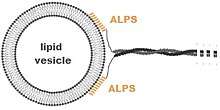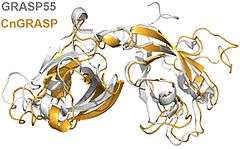Golgi matrix
The Golgi matrix is a collection of proteins involved in the structure and function of the Golgi apparatus.[1][2][3] The matrix was first isolated in 1994 as an amorphous collection of 12 proteins that remained associated together in the presence of detergent (which removed Golgi membranes) and 150 mM NaCl (which removed weakly associated proteins).[4] Treatment with a protease enzyme removed the matrix, which confirmed the importance of proteins for the matrix structure.[4] Modern freeze etch[5] electron microscopy (EM) clearly shows a mesh connecting Golgi cisternae and associated vesicles.[6][7] Further support for the existence of a matrix comes from EM images showing that ribosomes are excluded from regions between and near Golgi cisternae.[8][9][10][11][12][13]

Structure and function


The first individual protein component of the matrix was identified in 1995 as Golgin A2 (then called GM130).[14] Since then, many other golgin family proteins have been found to be in the Golgi matrix[2] and are associated with the Golgi membranes in a variety of ways.[15][1] For example, GMAP210 (Golgi Microtubule Associated Protein 210) has an ALPS (Amphipathic Lipid-Packing Sensor) motif in the N-termal 38 amino acids and an ARF1-binding domain called GRAB (Grip-Related Arf-Binding) at the C-terminus.[16] Thus, the GRAB-domain can bind indirectly to Golgi cisternae and its ALPS motif can tether vesicles.[17] Golgins have coiled-coil domains and are thus predicted to have elongated structures[2] up to 200 nm in length.[18] Most are peripheral membrane proteins attached at one end to Golgi membranes.[2] They have flexible regions between the coiled-coil domains, which make them ideal candidates for mediating the dynamic vesicle docking to Golgi cisternae and dynamic structure of the Golgi itself.[2]
Golgi reassembly-stacking proteins are an evolutionarily conserved family of proteins in the Golgi matrix.[2] GRASP65 and GRASP55 are the 2 human GRASPs. These proteins were named from their requirement for accurate Golgi reassembly during an in vitro assay,[2] but they have also been shown to function in vivo, as shown in the accompanying figure.[19] GRASPs associate with lipid bilayers because they are myristoylated and their myristic acid residue intercalates into the lipid layer.[7] Their trans oligomerization is controlled by phosphorylation[6] and is thought to explain the fragmentation of the Golgi as required during mitosis.[7]
Components
Disease associations
- CG-NAP hereditary Long QT syndrome LQT11[20]
- COH1 Cohen Syndrome[21]
- GMAP210 Achondrogenesis type IA[22]
- Golgin A2 a complex, neuromuscular disorder[23]
- GORAB Gerodermia osteodysplastica[24]
References
- Short B, Haas A, Barr FA (2005). "Golgins and GTPases, giving identity and structure to the Golgi apparatus". Biochimica et Biophysica Acta (BBA) - Molecular Cell Research. 1744 (3): 383–95. doi:10.1016/j.bbamcr.2005.02.001. PMID 15979508.
- Xiang Y, Wang Y (2011). "New components of the Golgi matrix". Cell and Tissue Research. 344 (3): 365–79. doi:10.1007/s00441-011-1166-x. PMC 3278855. PMID 21494806.
- Lowe, M (2011). "Structural organization of the Golgi apparatus". Current Opinion in Cell Biology. 23 (1): 85–93. doi:10.1016/j.ceb.2010.10.004. PMID 21071196.
- Slusarewicz P, Nilsson T, Hui N, Watson R, Warren G (1994). "Isolation of a matrix that binds medial Golgi enzymes". The Journal of Cell Biology. 124 (4): 405–13. doi:10.1083/jcb.124.4.405. PMC 2119912. PMID 8106542.
- Heuser JE (2011). "The origins and evolution of freeze-etch electron microscopy". Journal of Electron Microscopy. 60 Suppl 1: S3–29. doi:10.1093/jmicro/dfr044. PMC 3202940. PMID 21844598.
- Zhang, X. and Wang, Y. "Golgi structure and the role of GRASP65 in Golgi stack formation". Retrieved 27 May 2017.CS1 maint: multiple names: authors list (link)
- Zhang, X. and Wang, Y., Front Cell Dev Biol. 2015; 3: 84. Published online 2016 Jan 6. doi: 10.3389/fcell.2015.00084 (2015). "GRASPs in Golgi Structure and Function". Frontiers in Cell and Developmental Biology. 3: 84. doi:10.3389/fcell.2015.00084. PMC 4701983. PMID 26779480.CS1 maint: multiple names: authors list (link)
- Fig. 14 in Mogelsvang S, Gomez-Ospina N, Soderholm J, Glick BS, Staehelin LA (2003). "Tomographic Evidence for Continuous Turnover of Golgi Cisternae in Pichia pastoris". Molecular Biology of the Cell. 14 (6): 2277–91. doi:10.1091/mbc.e02-10-0697. PMC 260745. PMID 12808029.
- Staehelin LA and Kang BH. "Electron tomographic model of a Golgi stack and its encompassing, ribosome-excluding scaffold (Golgi matrix)". plantphysiol.org. American Society of Plant Biologists. Retrieved 27 May 2017.
- Staehelin LA and Kang BH. "Transfer of COPII vesicles and their scaffolds to the cis-Golgi matrix". plantphysiol.org. American Society of Plant Biologists. Retrieved 27 May 2017.
- Lucocq JM, Pryde JG, Berger EG, Warren G (1987). "A mitotic form of the Golgi apparatus in HeLa cells". The Journal of Cell Biology. 104 (4): 865–74. doi:10.1083/jcb.104.4.865. PMC 2114436. PMID 3104351.
- Mogelsvang S, Gomez-Ospina N, Soderholm J, Glick BS, Staehelin LA (2003). "Tomographic evidence for continuous turnover of Golgi cisternae in Pichia pastoris". Molecular Biology of the Cell. 14 (6): 2277–91. doi:10.1091/mbc.E02-10-0697. PMC 260745. PMID 12808029.
- Staehelin LA, Kang BH (2008). "Nanoscale architecture of endoplasmic reticulum export sites and of Golgi membranes as determined by electron tomography". Plant Physiology. 147 (4): 1454–68. doi:10.1104/pp.108.120618. PMC 2492626. PMID 18678738.
- Nakamura N, Rabouille C, Watson R, Nilsson T, Hui N, Slusarewicz P, Kreis TE, Warren G (1995). "Characterization of a cis-Golgi matrix protein, GM130". The Journal of Cell Biology. 131 (6 Pt 2): 1715–26. doi:10.1083/jcb.131.6.1715. PMC 2120691. PMID 8557739.
- Benjamin Short, Alexander Haas, Francis A. Barr. "Golgins associate with Golgi membranes in a variety of ways". ars.els-cdn.com/. Biochimica et Biophysica Acta (BBA) - Molecular Cell Research. Retrieved 31 May 2017.CS1 maint: multiple names: authors list (link)
- Cardenas J, Rivero S, Goud B, Bornens M, Rios RM (2009). "Golgi localisation of GMAP210 requires two distinct cis-membrane binding mechanisms". BMC Biology. 7: 56. doi:10.1186/1741-7007-7-56. PMC 2744908. PMID 19715559.
- Doucet CM, Esmery N, de Saint-Jean M, Antonny B (2015). "Membrane Curvature Sensing by Amphipathic Helices Is Modulated by the Surrounding Protein Backbone". PLOS ONE. 10 (9): e0137965. doi:10.1371/journal.pone.0137965. PMC 4569407. PMID 26366573.
- Drin G, Morello V, Casella JF, Gounon P, Antonny B (2008). "Asymmetric tethering of flat and curved lipid membranes by a golgin". Science. 320 (5876): 670–3. doi:10.1126/science.1155821. PMID 18451304.
- Wang Y, Wei JH, Bisel B, Tang D, Seemann J (2008). "Golgi cisternal unstacking stimulates COPI vesicle budding and protein transport". PLOS ONE. 3 (2): e1647. doi:10.1371/journal.pone.0001647. PMC 2249924. PMID 18297130.
- Chen L, Marquardt ML, Tester DJ, Sampson KJ, Ackerman MJ, Kass RS (2007). "Mutation of an A-kinase-anchoring protein causes long-QT syndrome". Proceedings of the National Academy of Sciences of the United States of America. 104 (52): 20990–5. doi:10.1073/pnas.0710527105. PMC 2409254. PMID 18093912.
- Kolehmainen J, Black GC, Saarinen A, et al. (2003). "Cohen syndrome is caused by mutations in a novel gene, COH1, encoding a transmembrane protein with a presumed role in vesicle-mediated sorting and intracellular protein transport". Am. J. Hum. Genet. 72 (6): 1359–69. doi:10.1086/375454. PMC 1180298. PMID 12730828.
- Smits P, Bolton AD, Funari V, Hong M, Boyden ED, Lu L, Manning DK, Dwyer ND, Moran JL, Prysak M, Merriman B, Nelson SF, Bonafé L, Superti-Furga A, Ikegawa S, Krakow D, Cohn DH, Kirchhausen T, Warman ML, Beier DR (2010). "Lethal skeletal dysplasia in mice and humans lacking the golgin GMAP-210". The New England Journal of Medicine. 362 (3): 206–16. doi:10.1056/NEJMoa0900158. PMC 3108191. PMID 20089971.
- Shamseldin HE, Bennett AH, Alfadhel M, Gupta V, Alkuraya FS (2016). "GOLGA2, encoding a master regulator of golgi apparatus, is mutated in a patient with a neuromuscular disorder". Human Genetics. 135 (2): 245–51. doi:10.1007/s00439-015-1632-8. PMC 4975006. PMID 26742501.
- Hennies HC, Kornak U, Zhang H, et al. (December 2008). "Gerodermia osteodysplastica is caused by mutations in SCL1BP1, a Rab-6 interacting golgin". Nat. Genet. 40 (12): 1410–2. doi:10.1038/ng.252. PMC 3122266. PMID 18997784.